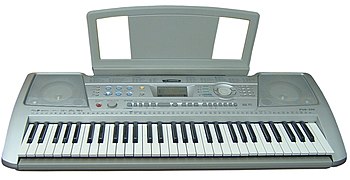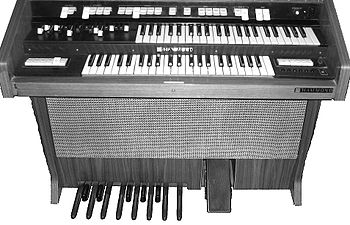 |
| Yamaha electronic keyboard (Photo credit: Wikipedia) |
From its first manifestation in ancient Rome until the 14th century, the organ remained the only keyboard instrument. It often did not feature a keyboard at all, instead utilizing large levers or buttons that were operated by using the whole hand.
The subsequent appearance of the clavichord and harpsichord in the 1300's was accelerated by the standardization of the 12-tone keyboard of white natural keys and black sharp/flat keys found on all keyboard instruments of today. The popularity of the clavichord and harpsichord was eventually eclipsed by the development and widespread adoption of the piano in the 18th century. The piano was a revolutionary advancement in acoustic musical keyboards because a pianist could vary the volume (or dynamics) of the sound the instrument produced by varying the force with which each key was struck.
The emergence of electronic sound technology in the 18th century was the next essential step in the development of the modern electronic keyboard. The first electrified musical instrument was thought to be the Denis d'Or (built by Vaclav Prokop Dovis), dating from about 1753. This was shortly followed by the "clavecin electrique" invented by Jean Baptiste Thillaie de Laborde around 1760. The former instrument consisted of over 700 strings temporarily electrified to enhance their sonic qualities. The later was a keyboard instrument featuring plectra, or picks, that were activated electrically.
While being electrified, neither the Denis d'Or or the clavecin used electricity as a sound source. In 1876, Elisha Gray invented such an instrument called the "musical telegraph.," which was, essentially, the very first analog electronic synthesizer. Gray discovered that he could control sound from a self-vibrating electromagnetic circuit, and so invented a basic single note oscillator. His musical telegraph created sounds from the electromagnetic oscillation of steel reeds and transmitted them over a telephone line. Grey went on to incorporate a simple loudspeaker into his later models which consisted of a diaphragm vibrating in a magnetic field, making the tone oscillator audible.
Lee De Forrest, the self-styled "Father Of Radio," was the next major contributor to the development of the electronic keyboard. In 1906 he invented the triode electronic valve or "audion valve." The audion valve was the first thermionic valve or "vacuum tube," and De Forrest built the first vacuum tube instrument, the "Audion Piano," in 1915. The vacuum tube became an essential component of electronic instruments for the next 50 years until the emergence and widespread adoption of transistor technology.
The decade of the 1920's brought a wealth of new electronic instruments onto the scene including the Theremin, the Ondes Martenot, and the Trautonium.
The next major breakthrough in the history of electronic keyboards came in 1935 with the introduction of the Hammond Organ. The Hammond was the first electronic instrument capable of producing polyphonic sounds and remained so until the invention of the Chamberlin Music Maker, and the Mellotron in the late 1940's and early 1950's. The Chamberlin and the Mellotron were the first ever sample-playback keyboards intended for making music.
The electronic piano made its first appearance in the 1940's with the "Pre-Piano" by Rhodes (later Fender Rhodes). This was a three and a half octave instrument made from 1946 until 1948 that came equipped with self-amplification. In 1955 the Wurlitzer Company debuted their first electric piano, "The 100."
The rise of music synthesizers in 1960 gives a powerful push to the evolution of the electronic musical keyboards we have today. The first synthesizers were extremely large, unwieldy machines used only in recording studios. The technological advancements and proliferation of miniaturized solid state components soon allowed the production of synthesizers that were self-contained, portable instruments capable of being used in live performances.
This began in 1964 when Bob Moog produced his "Moog Synthesizer." Lacking a keyboard, the Moog Synthesizer was not truly an electronic keyboard. Then, in 1970, Moog debuted his "Minimoog," a non-modular synthesizer with a built-in keyboard, and this instrument further standardized the design of electronic musical keyboards.
Most early analog synthesizers, such as the Minimoog and the Roland SH-100, were monophonic, capable of producing only one tone at a time. A few, such as the EML 101, ARP Odyssey, and the Moog Sonic Six, could produce two different tones at once when two keys were pressed. True polyphony (the production of multiple simultaneous tones which allow for the playing of chords) was only obtainable, at first, using electronic organ designs. There were a number of electronic keyboards produced which combined organ circuits with synthesizer processing. These included Moog's Polymoog, Opus 3, and the ARP Omni.
By 1976, additional design advancements had allowed the appearance of polyphonic synthesizers such as the Oberheim Four-Voice, and the Yamaha series CS-50, CS-60, and CS-80. The first truly practical polyphonic synth, introduced in 1977, was the Sequential Circuits Prophet-5. This instrument was the first to use a microprocessor as a controller and also allowed all knob settings to be saved in computer memory and recalled by simply pushing a button. The Prophet-5's design soon became the new standard in the electronic keyboards industry.
The adoption of Musical Instrumental Digital Interface (MIDI) as the standard for digital code transmission (allowing electronic keyboards to be connected to computers and other devices for input and programming), and the ongoing digital technological revolution have produced tremendous advancements in all aspects of electronic keyboard design, construction, function, sound quality, and cost. Today's manufactures, such as Casio, Yamaha, Korg, Rolland, and Kurzweil, are now producing an abundance of well-built, lightweight, versatile, great sounding, and affordable electronic keyboard musical instruments and will continue to do so well into the foreseeable future.
Preston Champion is an Internet researcher and consumer product and services, reviewer. He is also a musician and a music industry professional.
Preston provides unbiased, informative product reviews of many of the most popular and best selling electronic keyboards on the market on his website: http://electronickeyboardsreview.com.
Article Source: EzineArticles
|

